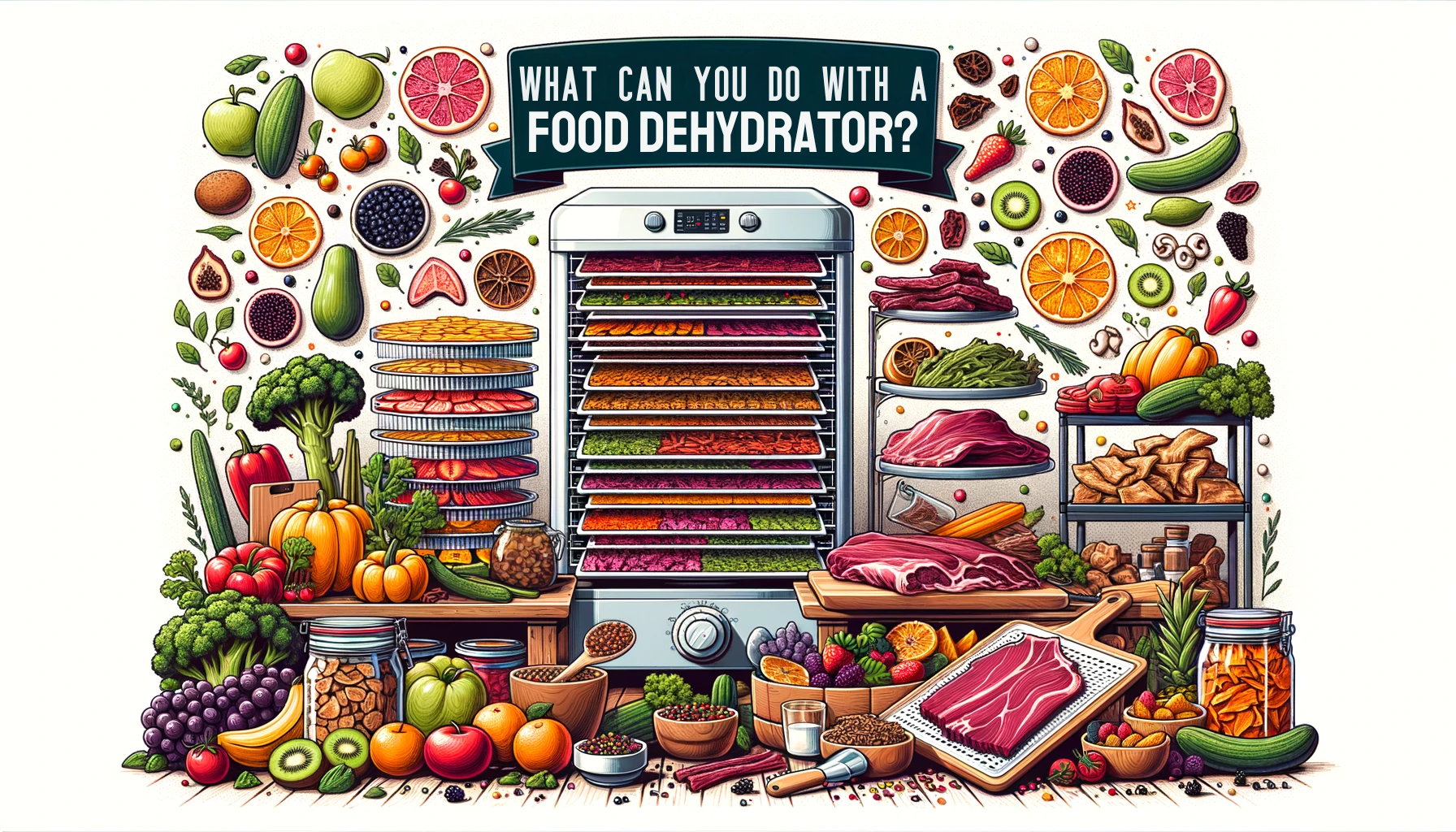Interested in using a food dehydrator but concerned about its safety? Look no further! This article dives into the question of whether Food dehydrators are safe or not. Find out what experts have to say about the potential risks and benefits associated with these appliances. From preserving the nutritional value of fruits and vegetables to avoiding harmful bacteria growth, we’ll explore everything you need to know to make an informed decision about using a food dehydrator. So sit back, relax, and let’s uncover the safety behind this popular kitchen gadget!
Overview
What are food dehydrators?
Food dehydrators are kitchen appliances that use low heat and airflow to remove moisture from food, thereby preserving it for longer periods. By dehydrating foods, the moisture content is greatly reduced, which inhibits the growth of bacteria and mold. This process also concentrates the flavors of the foods, providing a delicious and nutritious snack.
How do food dehydrators work?
Food dehydrators work by circulating warm air throughout the appliance. The heat is typically generated by an electric heating element, and a fan helps evenly distribute the air. The warm air gently removes moisture from the food, drying it out without damaging the nutritional value or taste. Some food dehydrators even offer adjustable temperature settings, allowing you to control the drying process.
Main safety concerns
While food dehydrators are generally safe to use, there are a few safety concerns that should be addressed. The main concerns include the potential growth of bacteria and mold, the possibility of cross-contamination, and the need for proper temperature control. By understanding and addressing these concerns, you can ensure the safety of your dehydrated foods.
Potential Contaminants
Bacteria growth
Bacteria can thrive in moist environments, making it essential to properly dehydrate your foods. Low heat and constant airflow remove the moisture that bacteria need to grow, effectively inhibiting their growth. It is crucial to follow recommended temperature guidelines and thoroughly dry your foods to minimize the risk of bacterial contamination.
Mold growth
Mold is another concern when using food dehydrators. Mold spores are naturally present in the air and can settle on your food, potentially causing spoilage. To prevent mold growth, ensure that your food is properly washed and thoroughly dried before placing it in the dehydrator. Proper cleaning and maintenance of the dehydrator will also help prevent mold from forming.
Cross-contamination
Cross-contamination occurs when bacteria from one food item spread to another, potentially causing foodborne illnesses. To avoid cross-contamination, it is crucial to clean your dehydrator thoroughly after each use and sanitize it properly. Additionally, ensure that you separate different types of foods when dehydrating, and give particular attention to raw meats and seafood.
Safe Food Preparation
Choosing high-quality ingredients
To ensure the safety and quality of your dehydrated foods, always choose the freshest and highest-quality ingredients. Inspect your fruits, vegetables, and meats for any signs of spoilage or damage before dehydrating them. Choosing high-quality ingredients from the start will minimize the risk of bacterial contamination and increase the overall taste and nutritional value of the final product.
Proper washing and sanitizing
Before dehydrating any food, it is essential to wash them thoroughly to remove any dirt, bacteria, or pesticides present on the surface. Use clean, running water to rinse the food items, and if necessary, gently scrub them to remove any stubborn dirt. Additionally, sanitize the cutting boards, knives, and other utensils used during food preparation to prevent cross-contamination.
Cutting and arranging food
Properly cutting and arranging the food can help ensure even drying and reduce the risk of bacteria growth. Slice the food into uniform thickness to ensure consistent drying times. For fruits and vegetables, arrange them in a single layer on the dehydrator trays, allowing proper airflow between each piece. Avoid overcrowding the trays, as this can lead to uneven drying and potential bacterial contamination.
Temperature Control
Importance of temperature control
Temperature control is crucial when using food dehydrators to ensure the safety and quality of the dehydrated foods. Different foods require specific temperatures for proper drying. Following the recommended temperature guidelines for each type of food helps eliminate bacteria and ensures the foods are dehydrated thoroughly.
Recommended temperatures for different foods
Different foods have different moisture content and require specific temperatures for proper drying. Fruits generally dry well between 130°F and 140°F (54°C and 60°C), while vegetables and meats typically require temperatures between 140°F and 160°F (60°C and 71°C). It is essential to consult reliable sources or the manufacturer’s guidelines to determine the appropriate temperatures for the specific foods you are dehydrating.
Avoiding undercooking and overcooking
Maintaining the proper temperature throughout the dehydration process ensures that the food is neither undercooked nor overcooked. Undercooking can result in the survival of bacteria, while overcooking can lead to loss of nutritional value and undesirable taste. Regularly check the temperature of your dehydrator and monitor the progress of your food to achieve the desired results.
Ventilation and Airflow
Importance of proper ventilation
Proper ventilation is critical for food dehydrators to effectively remove moisture from the food and prevent condensation and moisture buildup. The constant circulation of air ensures an even drying process while inhibiting the growth of bacteria and mold. Ensure that the vents and air pathways of your dehydrator are clear and unobstructed to maintain optimal ventilation.
Preventing condensation and moisture buildup
Condensation and moisture buildup can occur if the dehydrator lacks proper ventilation or air circulation. This can create a moist environment ideal for bacterial growth and cause the food to spoil prematurely. To prevent condensation, leave space between the food items on the trays, allowing air to circulate freely. Additionally, consider rotating the trays during the dehydration process to ensure even drying and minimize moisture accumulation.
Ensuring even drying
Even drying is crucial to prevent bacterial growth and achieve the desired texture and taste in dehydrated foods. Proper airflow and ventilation help ensure that all parts of the food are exposed to warm air, facilitating even drying. Regularly rotate the trays within the dehydrator to ensure that no areas are left damp or under-dried. By following these practices, you can achieve consistent results and reduce the risk of contamination.
Food Dehydration Techniques
Pre-treatment methods
Pre-treatment methods can enhance the safety and flavor of the dehydrated foods. Blanching certain fruits and vegetables in boiling water for a short period before dehydration can help destroy potential bacteria or enzymes. Acidic foods like citrus fruits can benefit from a quick dip in a citrus acid solution to help preserve their color and flavor. Research appropriate pre-treatment methods for the specific foods you are dehydrating to optimize the results.
Using marinades and spices
Marinating the food before dehydration can add flavor and depth to the final product. However, it’s essential to note that marinades do not aid in food preservation. Ensure that you marinate the food in the refrigerator and discard any leftover marinade that comes into contact with raw meats or seafood. Using spices and herbs in moderation can enhance the taste of dehydrated foods without compromising their safety.
Ensuring proper dehydration time
The duration of dehydration varies depending on the type and thickness of the food being dried. It is essential to follow the recommended drying times for each food to prevent the risk of under or over-drying. Regularly check the foods for dryness and texture throughout the drying process. Proper dehydration time ensures that the food is safe to consume, retains its nutritional value, and has the desired texture.
Storage and Preservation
Choosing appropriate containers
Proper storage and container selection are essential for maintaining the quality and safety of dehydrated foods. Choose airtight containers made of food-grade materials such as glass jars, plastic containers, or vacuum-sealed bags. Ensure that the containers are clean, dry, and free from any previous food residue or contamination. Label each container with the contents and date to keep track of the storage time.
Preventing oxidation
Oxidation can lead to the degradation of the dehydrated food’s color, texture, flavor, and nutritional value. To prevent oxidation, use oxygen absorbers or vacuum-seal the containers to remove excess air. Additionally, consider adding a small amount of citric acid or vitamin C tablets to the foods prone to oxidation, such as fruits or vegetables, to help retain their vibrant colors and nutritional content.
Storing dehydrated food properly
Proper storage is crucial for maintaining the safety and shelf life of dehydrated foods. Store the containers in a cool, dark, and dry place away from sunlight, heat, and moisture. Regularly check the containers for any signs of spoilage or pests, and discard any dehydrated foods that show signs of mold, off-odors, or unusual discoloration. Following these storage practices will ensure that your dehydrated foods remain safe and enjoyable for an extended period.
Common Safety Missteps
Using dehydrators outdoors
Using dehydrators outdoors can expose the appliance to unpredictable weather conditions, pests, and potential contamination. It is recommended to use food dehydrators indoors where environmental factors can be controlled. This helps minimize the risk of foodborne illnesses and ensures the safety and quality of the dehydrated foods.
Neglecting to clean dehydrators regularly
Regular cleaning is essential to prevent the buildup of bacteria, mold, and other contaminants. Thoroughly clean and sanitize your food dehydrator after each use, paying special attention to removable parts, trays, and vents. Follow the manufacturer’s instructions for cleaning and maintenance, and ensure that the dehydrator is completely dry before storing it.
Storing food without proper finishing
After dehydration, it is crucial to give your dehydrated foods a proper finishing step to ensure their safety. This may include heat-sterilizing the food in the oven or freezer for a brief period to eliminate any potential bacteria or pests that may have survived the dehydration process. Follow recommended finishing techniques for the specific foods you have dehydrated to minimize the risk of contamination.
Electrical Safety
Avoiding water contact
To ensure electrical safety, avoid any contact between water and the dehydrator, as it can lead to electrical shock or damage to the appliance. Keep the dehydrator away from sinks, faucets, or any other water sources. Additionally, ensure that your hands are dry before handling or plugging in the appliance to prevent accidents.
Maintaining proper wiring
Regularly inspect the power cord and wiring of the dehydrator for any signs of damage or wear. Frayed or damaged wires can pose an electrical hazard. If you notice any issues, promptly replace the power cord or consult a professional to repair the appliance. Do not attempt to use the dehydrator if you suspect any electrical issues.
Checking for safety certifications
When purchasing a food dehydrator, look for safety certifications such as the UL mark, which indicates that the appliance has undergone rigorous testing to meet safety standards. Choosing a dehydrator with recognized certifications provides an added assurance of its safety and reliability.
Conclusion
Benefits of using food dehydrators
Food dehydrators offer many benefits, including preserving the nutritional value of foods, reducing waste, and providing a convenient and delicious snack option. By dehydrating your own foods, you have control over the quality, ingredients, and flavors, making it a rewarding and budget-friendly alternative to store-bought snacks.
Following proper safety guidelines for a rewarding experience
To ensure the safety of your dehydrated foods, it is crucial to follow proper safety guidelines. From selecting high-quality ingredients and practicing safe food preparation techniques to maintaining proper temperature control and implementing adequate ventilation, each step plays a vital role in ensuring the safety and quality of the final product.
Final considerations
Food dehydrators are safe appliances when used correctly and with proper precautions. However, it is essential to be vigilant and mindful of potential safety concerns such as bacterial and mold growth, cross-contamination, and electrical safety. By following the comprehensive guidelines outlined in this article, you can enjoy the benefits of food dehydrators while prioritizing the safety and quality of your dehydrated foods.


